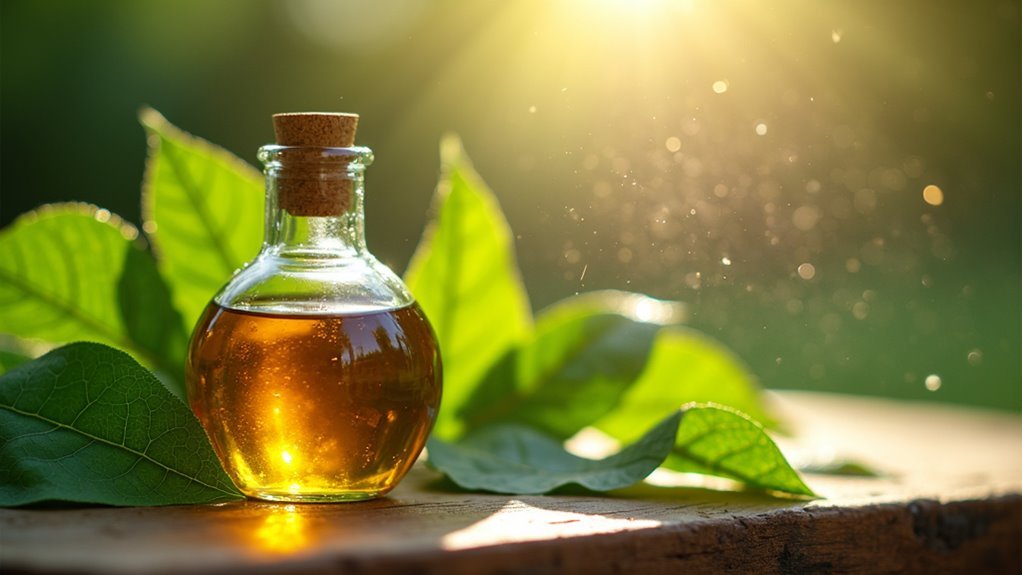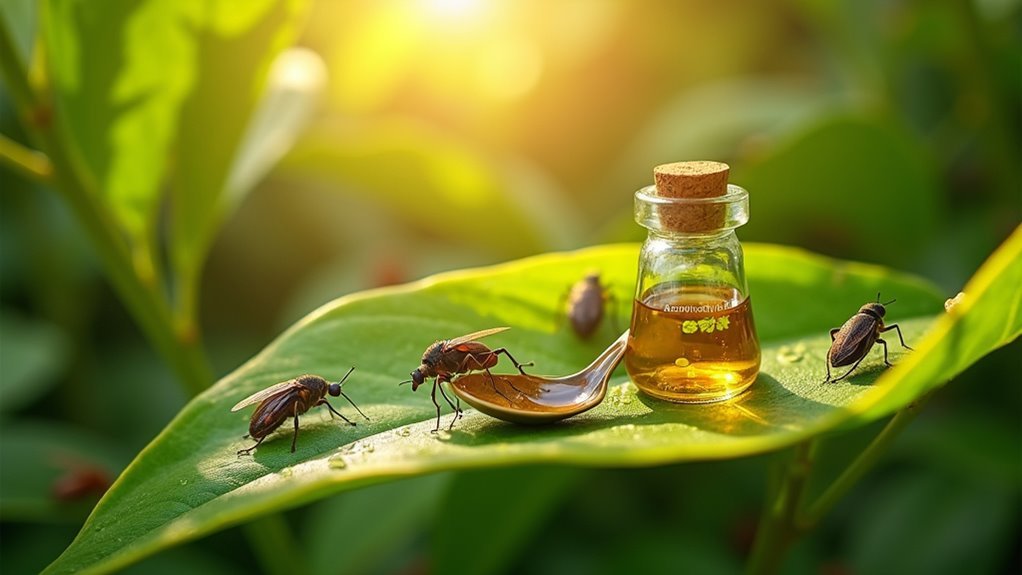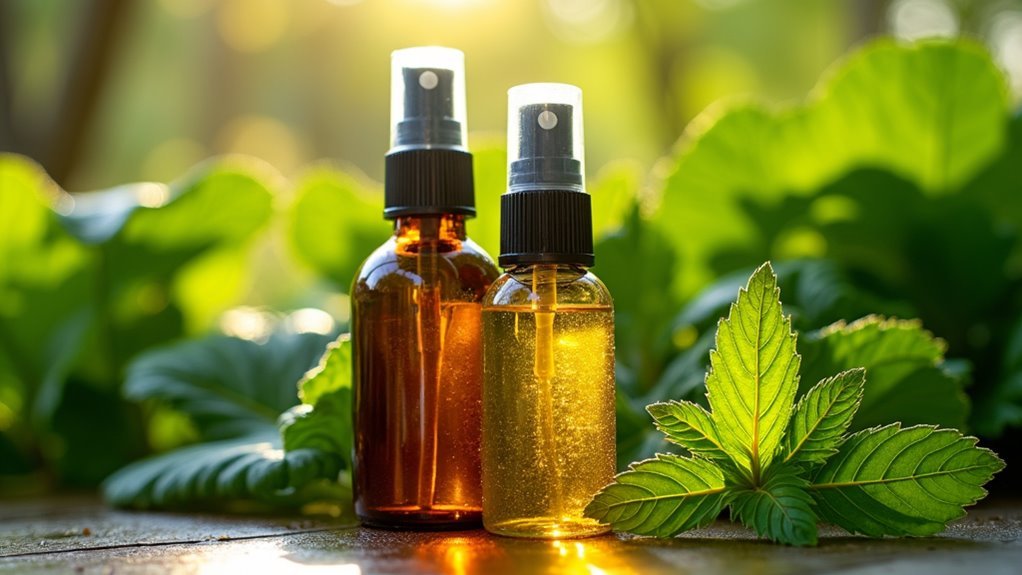You’ll find the best neem oil sprays contain cold-pressed neem oil with at least 0.5% azadirachtin concentration, which disrupts insect hormonal systems and prevents feeding. Look for OMRI-certified organic products that explicitly state “cold-pressed” on the label, ensuring no synthetic chemicals or harmful additives. Quality formulations include beneficial compounds like nimbin and nimbidin for antifungal properties, plus essential fatty acids for enhanced pest control. Understanding these key ingredients will help you select the most effective spray for your garden.
Understanding Cold-Pressed Neem Oil as the Foundation

When you’re selecting the best neem oil spray, cold-pressed neem oil serves as the gold standard foundation that’ll deliver the most effective pest control results.
This mechanical extraction method preserves azadirachtin, the primary active ingredient responsible for controlling pests, mites, and fungal diseases. You’ll recognize quality cold-pressed neem oil by its golden-yellow color and distinctive garlic-like smell, which indicates high fatty acid content that benefits plant health.
Cold-pressed varieties contain higher concentrations of active compounds compared to solvent-extracted alternatives, making your pest management efforts more effective while reducing resistance development.
This extraction method aligns perfectly with organic gardening principles, offering an environmentally friendly solution that’s biodegradable and safe for beneficial insects in your garden.
Essential Active Ingredients That Make Neem Oil Effective
The powerhouse behind neem oil’s effectiveness lies in azadirachtin, a complex compound that disrupts insect hormonal systems and prevents pests from feeding, growing, and reproducing in your garden.
You’ll find the highest concentration of this active ingredient in cold-pressed neem oil, which preserves its potency better than steam or solvent extraction methods.
Beyond azadirachtin, you’re getting essential fatty acids that provide moisturizing benefits while enhancing pest control effectiveness.
Additional compounds like nimbin and nimbidin deliver powerful antifungal and antibacterial properties, giving you extensive protection against diseases and various garden threats.
What makes neem oil particularly valuable is its biodegradable nature—it breaks down quickly without leaving harmful residues, making it perfect for organic gardening practices.
Why Azadirachtin Concentration Matters for Pest Control

When you’re choosing neem oil spray, azadirachtin concentration directly determines how effectively it’ll disrupt pest hormonal systems and reproductive cycles.
Higher concentrations pack more punch against various life stages of insects, from eggs to adults, giving you broader spectrum control.
You’ll want products with at least 0.5% azadirachtin to guarantee the active ingredient potency actually makes a measurable impact on your pest problems.
Active Ingredient Potency
Azadirachtin concentration separates effective neem oil sprays from watered-down alternatives that’ll leave your plants vulnerable to pest damage. The active ingredient’s potency determines whether your pest control efforts succeed or fail against over 200 pest species.
Cold pressed neem maintains higher azadirachtin levels than heat-processed alternatives, giving you maximum bang for your buck. You’ll want concentrations between 0.5% to 1% for ideal results.
| Processing Method | Azadirachtin Retention |
|---|---|
| Cold Pressed | High (ideal) |
| Heat Processed | Medium (reduced) |
| Solvent Extracted | Low (compromised) |
| Refined | Minimal (poor) |
Higher potency neem oil products resist pest adaptation, ensuring long-term garden protection. Monitor your spray’s azadirachtin levels regularly, as degradation reduces effectiveness over time.
Pest Disruption Effectiveness
Understanding potency levels means nothing without knowing how azadirachtin actually stops pests in their tracks. This powerful compound disrupts pest hormonal systems, preventing growth, reproduction, and feeding behaviors across over 200 species including aphids, spider mites, and whiteflies.
Higher azadirachtin concentrations deliver broad-spectrum pest control that provides systemic plant protection lasting up to three weeks.
You’ll get maximum effectiveness from cold-pressed neem oil formulations, which preserve considerably more azadirachtin than solvent-extracted alternatives. This preservation matters because ideal azadirachtin levels prevent pest resistance development—a major advantage over synthetic pesticides.
When you choose neem oil with proper azadirachtin concentration, you’re investing in sustainable pest control that targets multiple species while maintaining long-term effectiveness.
Organic Certification and Quality Standards to Look For
When you’re shopping for neem oil spray, you’ll want to look for OMRI certification, which guarantees the product meets strict organic standards without synthetic additives.
Cold-pressed processing methods are equally important since they preserve higher levels of azadirachtin, the compound that makes neem oil effective against pests.
These two quality markers confirm you’re getting a potent, truly organic product that won’t compromise your garden’s health.
OMRI Certification Standards
Since organic gardening demands the highest quality standards, you’ll want to prioritize neem oil products that carry OMRI (Organic Materials Review Institute) certification.
When you see “OMRI Listed for Organic” on a product label, you’re guaranteed that the neem oil meets strict organic standards without synthetic chemicals or harmful additives.
The certification process thoroughly evaluates composition, extraction methods, and environmental impact to guarantee alignment with organic farming principles.
These neem oil products are completely biodegradable and leave no harmful residues, making them safe to use around beneficial insects and pets.
You can trust that OMRI-certified products have undergone rigorous testing and approval for compliance with organic production standards, giving you confidence in their quality and safety.
Cold-Pressed Processing Methods
Cold-pressed neem oil represents the gold standard for organic pest control because it preserves the maximum concentration of azadirachtin, the key compound that makes neem oil so effective against garden pests. This extraction method uses no heat or chemicals, maintaining the oil’s natural integrity and biodegradability.
| Quality Indicator | What to Look For |
|---|---|
| Processing Method | Cold-pressed extraction only |
| Purity Level | 100% pure formulation |
| Certification | OMRI listing or organic certification |
| Additives | Free from lauryl sulfates and parabens |
When you’re shopping for neem oil, you’ll want products that specifically state “cold-pressed” on the label. This extraction method guarantees the active ingredient remains potent while supporting environmental safety through quick biodegradation without harmful residues.
Pure vs. Concentrated Formulations for Vegetable Gardens

Although both pure and concentrated neem oil formulations can effectively protect your vegetable garden from pests, understanding their key differences will help you choose the right option for your specific needs.
Pure Neem Oil offers maximum cost-effectiveness since you’ll dilute it yourself using 1-2 tablespoons per gallon of water. You’ll get more customizable pest control for your specific vegetable gardens, but you’ll need to mix fresh batches every 3-4 days.
Concentrated formulations contain higher percentages of active ingredients, delivering more potent pest control than ready-to-use sprays. While they’re pricier upfront, premixed versions last up to 18 months, offering convenience for long-term garden management without frequent mixing.
Safe Additives That Enhance Neem Oil Performance
Beyond selecting the right neem oil formulation, you can considerably boost your spray’s effectiveness by incorporating safe, natural additives that work synergistically with neem oil’s pest-fighting properties.
Adding mild liquid soap as an emulsifier helps neem oil mix properly with water, ensuring even coverage across plant surfaces. You’ll enhance insect-repelling properties by including essential oils like peppermint or clove oil, which also improve your spray’s scent.
Mixing in small amounts of baking soda boosts fungicidal properties, effectively combating powdery mildew and other fungal diseases. You can also incorporate horticultural oil for increased suffocating effects on pests or use plant-based surfactants to improve spreadability and adherence on plant surfaces.
Harmful Chemicals to Avoid in Commercial Sprays
While enhancing your neem oil spray with beneficial additives can dramatically improve results, you’ll want to steer clear of commercial products loaded with harmful chemicals that counteract neem’s natural benefits.
Many manufacturers contaminate their formulations with synthetic pesticides, lauryl sulfates, and parabens that reduce effectiveness and harm beneficial insects.
Watch out for these red flags in commercial products:
- Solvent extraction methods that destroy azadirachtin, neem’s active compound
- Artificial fragrances and dyes causing allergic reactions in sensitive individuals
- Synthetic pesticides negating organic benefits while harming pollinators
- Skin-irritating chemicals like lauryl sulfates creating environmental damage
Choose products labeled “100% pure” or “cold-pressed” to guarantee you’re getting untainted neem oil that delivers maximum pest control without compromising safety.
Extraction Methods That Preserve Maximum Potency
Since the extraction method directly determines your neem oil spray’s effectiveness, understanding how manufacturers process the oil becomes essential for selecting a product that’ll actually control pests.
Cold-pressed extraction preserves maximum azadirachtin potency—the active ingredient that makes neem oil such a powerful pest deterrent. This gentle method maintains beneficial compounds that steam distillation or solvent extraction destroys through excessive heat and pressure.
When you choose cold-pressed neem oil, you’re getting higher nutrient concentrations and superior pest management capabilities. These products often carry organic certification because they meet strict safety and potency standards without chemical degradation.
Look for labels explicitly stating “cold-pressed” extraction. This guarantees you’re purchasing the most effective formulation available, not a weakened version that’ll disappoint when battling garden pests.
Biodegradable Components for Environmental Safety
When you’re choosing neem oil sprays, you’ll want products with biodegradable components that break down quickly in your garden’s environment.
These eco-friendly formulations won’t leave harmful residues in your soil or waterways, ensuring your gardening practices don’t negatively impact the surrounding ecosystem.
You can protect your plants effectively while maintaining environmental safety through neem oil’s naturally biodegradable composition.
Quick Environmental Breakdown
Because neem oil’s biodegradable nature sets it apart from synthetic alternatives, you’re choosing a product that won’t harm your garden’s ecosystem long-term.
When you apply organic neem oil, it breaks down rapidly through natural processes, ensuring no toxic residues accumulate in your soil or waterways. This quick environmental breakdown means you can spray confidently without worrying about long-term ecological damage.
The decomposition process transforms neem oil into beneficial compounds that actually enhance soil health:
- Azadirachtin molecules dissolve naturally within days of application
- Microorganisms in your soil feast on neem’s organic components
- Nutrients from breakdown feed earthworms and beneficial bacteria
- Soil structure improves as decomposed neem enriches the earth
This biodegradable quality makes neem oil the environmentally responsible choice for sustainable pest management.
No Harmful Residues
This rapid decomposition directly translates to zero harmful residues lingering in your garden environment.
When you choose neem oil as your natural solution, you’re selecting a product that completely breaks down without leaving toxic traces behind. The azadirachtin compound derived from neem seeds guarantees your soil, water sources, and beneficial organisms remain protected from contamination.
Unlike synthetic alternatives, this biodegradable formula won’t accumulate in your garden ecosystem.
You’ll find that neem oil decomposes into completely harmless by-products, maintaining your commitment to sustainable gardening practices.
When you select OMRI-listed neem oil products, you’re assured compliance with strict organic standards. This certification confirms that no synthetic chemicals are present, protecting your pets, beneficial insects, and the broader environment from any potential harm.
Safe Plant Protection
As you protect your plants with neem oil spray, you’re employing one of nature’s most sophisticated defense mechanisms that works systematically within plant tissues.
This organic neem oil creates an internal shield that provides pest control for up to three weeks while remaining completely biodegradable. Unlike synthetic pesticides, neem oil’s natural compounds break down harmlessly in soil without accumulating toxic residues.
Your plant protection strategy becomes sustainable because neem oil targets over 200 pest species without harming beneficial insects when applied correctly:
- Azadirachtin disrupts pest feeding and reproduction cycles naturally
- Biodegradable components decompose quickly in environmental conditions
- Beneficial pollinators like bees continue visiting treated plants safely
- Soil microorganisms remain unharmed throughout the breakdown process
Storage Stability and Shelf Life Considerations
Understanding proper storage methods can considerably impact how long your neem oil remains effective for pest control applications. When you store neem oil concentrates in cool, dark places, you’ll get 1-2 years of shelf life, while premixed sprays last up to 18 months due to preservatives. Proper storage in airtight containers minimizes light and air exposure, preventing oxidation that degrades active compounds.
| Product Type | Storage Life | Storage Requirements |
|---|---|---|
| Concentrates | 1-2 years | Cool, dark place |
| Premixed sprays | 18 months | Airtight containers |
| Diluted solutions | 3-4 days | Use immediately |
Cold-pressed varieties retain more azadirachtin and offer better storage stability than heat-extracted options. Always check the manufacturer’s expiration date before application to guarantee maximum potency.
Application-Ready Formulas vs. DIY Concentrate Options
How do you decide between grabbing a ready-to-use bottle or mixing your own neem oil solution?
Application-ready neem oil sprays offer instant convenience for quick pest control treatments, while DIY concentrate options give you complete control over dilution ratios and costs.
Ready-to-use formulas often include beneficial additives that enhance effectiveness, but concentrates focus purely on neem oil’s active compounds.
Your choice depends on convenience versus customization preferences.
- Picture yourself reaching for a spray bottle during a sudden aphid invasion
- Imagine measuring concentrate into a gallon sprayer for extensive garden coverage
- Visualize storing unopened bottles for up to 18 months without worry
- See yourself customizing dilution strength based on specific plant needs
Both approaches work effectively—choose what fits your gardening style and treatment needs.
Frequently Asked Questions
What Are the Downsides of Neem Oil?
You’ll face several downsides with neem oil: it can harm beneficial insects like bees, cause leaf burn on sensitive plants, trigger allergic reactions, produce unpleasant odors, and lose effectiveness when mixed improperly.
What Is the Active Ingredient in Neem Oil?
The active ingredient you’ll find in neem oil is azadirachtin, which comes from neem tree seeds. It’s what gives neem oil its powerful insecticidal, fungicidal, and miticidal properties against pests.
What to Look for When Buying Neem Oil?
You should look for cold-pressed neem oil with high azadirachtin concentration that’s OMRI-listed or certified organic. Check the formulation carefully and avoid products with scent-enhancing oils that’ll dilute effectiveness.
What Should You Not Spray Neem Oil On?
You shouldn’t spray neem oil on delicate ferns, stressed plants, or flowers during blooming periods. Avoid treating plants showing fungal infections or applying during peak sunlight hours to prevent damage.
In Summary
You’ll want to choose a neem oil spray with cold-pressed extraction, high azadirachtin content, and organic certification. Don’t overlook biodegradable formulations that protect your garden’s ecosystem while maintaining storage stability. Whether you’re selecting a ready-to-use spray or concentrate for mixing, prioritize products that preserve neem’s natural potency through proper extraction methods. Your vegetables will benefit from this careful selection, giving you effective pest control without compromising plant health or environmental safety.





Leave a Reply